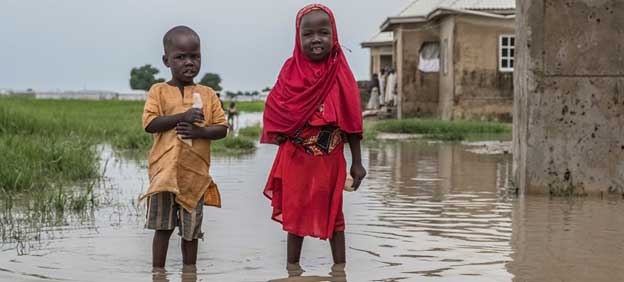BERLIN, Oct 25 (IPS) – In temperate zones lie most of the world’s richest countries, which have also been up till now the world’s major breadbaskets, in meeting international grain, oilseed and livestock product needs.
However, climate change is threatening to change the course of history, allowing some native pests to breed more frequently and longer, while invasive insects and pathogens are being spread more widely.
It is no coincidence that agriculture in temperate regions, such as much of Northern Europe and Northern America, is characterised by high productivity.
In temperate zones, agricultural sectors are highly capital intensive with new technologies continuously introduced; weather conditions during growing seasons are often predictably favourable; while harsh winters and cold springs prevent many plant pests and pathogens from overwintering, all leading to crop yields that are approaching their physiological ceilings, and at the same time storage losses being kept to a minimum.
In a nutshell
Pests and diseases can undergo rapid evolutionary changes through natural selection within the timescale of climate change. As the climate warms up, agricultural pests and diseases are advancing northwards and becoming more widespread.
Notwithstanding, the science that links climate change with changes to the behaviour of insect pests and pathogens is complex, given the latter’s multitude of biological responses and their interactions with changing environmental stimuli.
Invasive species, by definition, have succeeded in areas outside of their habitual range and therefore have higher adaptive capacity relative to native species. Evolution and adaptation are therefore the inherent mechanisms that explain why pests and diseases pose a consequential threat (both localised and transboundary) under a changing climate.
Natural selection also explains why an increasing number of insect pests have become resistant to pesticides.
Why should richer economies be worried? What science tell us
Drawing from a recent report on the scientific linkages between climate change and pest and disease outbreaks produced by TMG Think Tank for Sustainability and Climate Prediction and Applications Centre of Intergovernmental Authority on Development, temperature rise in temperate zones is likely to attract new pests that have migrated from areas where heat stress is too severe.
However, with warmer winters in northern latitudes there is strong likelihood of migration resulting in an increase in the build-up of insect pest populations to damaging levels owing to early emergence (shorter dormancy due to accelerated metabolic rates attributable to higher temperatures).
While there is uncertainty on whether invasive species can establish themselves in new environments, much will depend on factors such as the degree of temperature rise, food supply and natural enemies and whether they can maintain or adapt to the synchrony with growth cycles of plants on which they feed.
Warming will also have other detrimental effects, such as bringing about an increased number of generations of native and invasive insect pests through greater intra-year breeding, fostering rising population growth.
Ultimately, with a larger temperature window in temperate zones within which insects and pathogens can flourish combined with rising heat stress to crops, these zones could register rapid increases in pest and disease outbreaks, increased use of pesticides, increased costs to farmers and lower yields.
In fact, the transboundary and transoceanic expansion of invasive species is already heading northwards thanks to climate change including extreme events such as cyclones and storms, and further exacerbated by international trade and travel.
A case in point here is the recent spread of the destructive lanternflies to the United States, which have demonstrated great adaptability to new environments and pose imminent threat to vineyard based economies. Researchers further predict that corn earworm that ravages maize, cotton, soyabeans and vegetables is expanding northwards into the United States’ maize belt.
The UN estimates that at least 20 percent of all food crops grown worldwide are lost annually to plant pests and diseases. With the rich temperate countries becoming increasing vulnerable, total losses would increase.
Consequently, while there is a pressing need for scientific theory to provide further precision on pest-climate dynamics, as affirmed in the latest report of the Intergovernmental Panel on Climate Change (IPCC), action is needed now.
Harnessing technological leaps in the realm of artificial intelligence, will be critical for enhanced plant pest and disease surveillance, diagnostics and outbreak prediction via early warning systems.
As with all pest and disease outbreaks, prevention is far cheaper than dealing with full-blown crises, and what is more, pests and diseases are often impossible to eradicate once they have established themselves.
Alexander Müller is TMG’s Managing Director. He is a former Assistant Director-General of the Food and Agriculture Organization of the UN (FAO) and State Secretary for Consumer Protection, Food and Agriculture, Germany.
Adam Prakash is a TMG research associate, whose work explores the quantitative links between climate change and agriculture and how emerging technologies can de-risk food systems.
Elena Lazutkaite is an animal scientist and interdisciplinary researcher focusing on food and agriculture, transboundary pests and resilience, and environmental sustainability.
TMG Research gGmbH is an international not-for-profit think tank headquartered in Berlin, Germany, with an African regional office in Nairobi. Through action-oriented research with local and international partners, TMG triggers new thinking and “social innovations” to tackle entrenched governance challenges in the transition to a more sustainable future for people and planet.
IPS UN Bureau
© Inter Press Service (2022) — All Rights ReservedOriginal source: Inter Press Service
Check out our Latest News and Follow us at Facebook
Original Source

